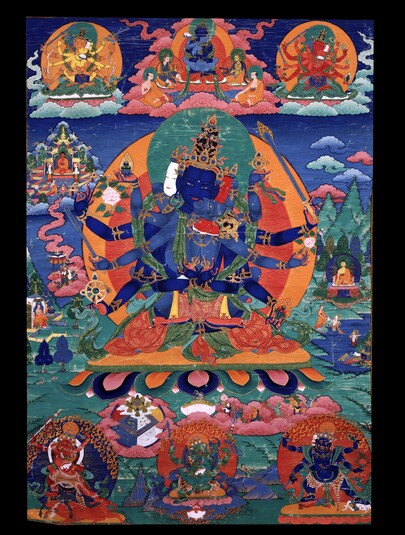
Item: Guhyasamaja (Buddhist Deity) - Akshobhyavajra
| Origin Location | Tibet |
|---|---|
| Date Range | 1600 - 1699 |
| Material | Ground Mineral Pigment on Cotton |
| Collection | Rubin Museum of Art |
| Catalogue # | acc.#C2001.1.3 |
Guhyasamaja, Akshobhyavajra (Tibetan: sang wa du pa, mi kyu dor je. English: Secret Gathering, Immovable Vajra), foremost tutelary deity of the Method-father class of Anuttarayoga tantra. 
Semi-peaceful in appearance, blue in colour, he has three faces, blue, white and red. The main pair of hands hold a vajra and bell embracing the consort, also with three faces. This form of Akshobhyavajra has only two eyes per face. Other traditions describe three eyes per face. In the remaining hands they both hold a lotus, wheel, sword and precious jewel. Adorned with peaceful ornaments and silk garments they sit atop a sun disc and multi-coloured lotus blossom surrounded by a red-orange nimbus and green aureola.
Akshobhyavajra Guhyasamaja Description: "...with a body blue in colour like sapphire, issuing forth rays of blazing light. The main face is blue with a mixed expression of fierceness and desire. The canine teeth are pointed and clenched, frowning and having three eyes. The right face is white in a peaceful manner, left face is red in a desirous manner. All three faces are adorned with very beautiful eyebrows. Each of the six hands are adorned with precious rings. The first two hands hold a nine pointed vajra and a bell embracing the consort [who is in] the same [appearance] as the [Father]. The right second [hand] holds a white wheel with eight spokes. The third [hand] holds a red lotus with eight petals. The left second [hand] holds a green jewel with nine facets. The third [hand] holds a sword, bright blue and blazing with rays of light. Seated with the legs in vajra posture, adorned with the thirty-two major and eighty minor marks, the hair, in braids, is tied on the crown of the head. The jewel on the crown of the head greatly blazes with soothing rays of light [like] the sun and moon. Adorned with eight [different types] of precious ornaments: a crown, earrings, choker, necklace, armlets, bracelets, long necklace and belt. The ears are made more beautiful with blue utpalas and ribbons; wearing various [heavenly] garments bright like Indra's bow [rainbow]." (Jamgon Amezhab, 1597-1659).
At the top center Vajradhara is surrounded by four figures, King Indrabhuti, a bodhisattva like figure and two monks. At the left side is orange Manjuvajra Guhyasamaja. At the right is red Lokeshvara Guhyasamaja, both in similar appearance to the central figure.
At the bottom center is Chaturbhuja Mahakala, green in colour with one face and four hands embracing the consort. At the left is Rakta Yamari, red, embracing the consort Vajra Vetali and riding atop a red buffalo. On the right side is wrathful blue Humkara with three faces and six hands. (See Yogambara and Kalachakra from the same set).
Jeff Watt 3-2000
In the book A History of Tibetan Painting by David Jackson, he says; "Another interesting reference to the mKhyen-ris style from the autobiography of the 5th Dalai Lama refers to the commisioning around 1670/71 of a set of tangkas depicting mandalas (dkyil thang) from the Vajravali cycle. The political ruler (sDe-pa) undertook to sponsor it. Since sMan-thang-pa had been perfectly expert in peaceful deities and mKhyen-brtse in fierce deities and mandalas, in the Great Fifth's opinion it was essential that both lineages should not die out," (pp.159-160).
Numbered List:
1. Guhyasamaja, Akshobhyavajra
2. Consort
3. Vajradhara
4. Indrabhuti
5. Teacher
6. Teacher
7. Teacher
8. Guhyasamaja, Manjuvajra
9. Guhyasamaja, Avalokita
10. Mahakala, Chaturbhuja, Wisdom Protector
11. Rakta Yamari, Meditational Deity
12. Humkara, Meditational Deity
HAR: Jeff Watt - Profile
Thematic Sets
Buddhist Deity: Guhyasamaja (Masterworks)
Subject: Composition - Floating Figure
Chinese Language: 中文主页, Main Page
Buddhist Deity: Guhyasamaja, Akshobhyavajra (Personal Painting)
Subject: Masterworks (Male Deity, 男神)
Collection of RMA: Painting Masterworks Page
Painting: Art Topics
Buddhist Deity: Akshobhya (Anuttarayoga, Secondary & Related Figures)
Buddhist Deity: Guhyasamaja - Lokeshvara
Collection of RMA: How or Why an Object was Acquired
Painting Tradition: Khyenri Main Page
Painting Sets: Compendium
Subject: Deities - Conceptual Categories
Buddhist Deity: Guhyasamaja Main Page
Collection of Rubin Museum of Art (RMA): Main Page
Painting Style: Khyenri - Peaceful Deities & Semi Peaceful
Buddhist Deity: Guhyasamaja, Akshobhyavajra (Painting Masterworks)
Buddhist Deity: Guhyasamaja, Akshobhyavajra
Painting Set: Vajravali (Kyenri Style)
Painting Style: Examples
Exhibition: Big!
Collection of RMA: Best of Collection 1


